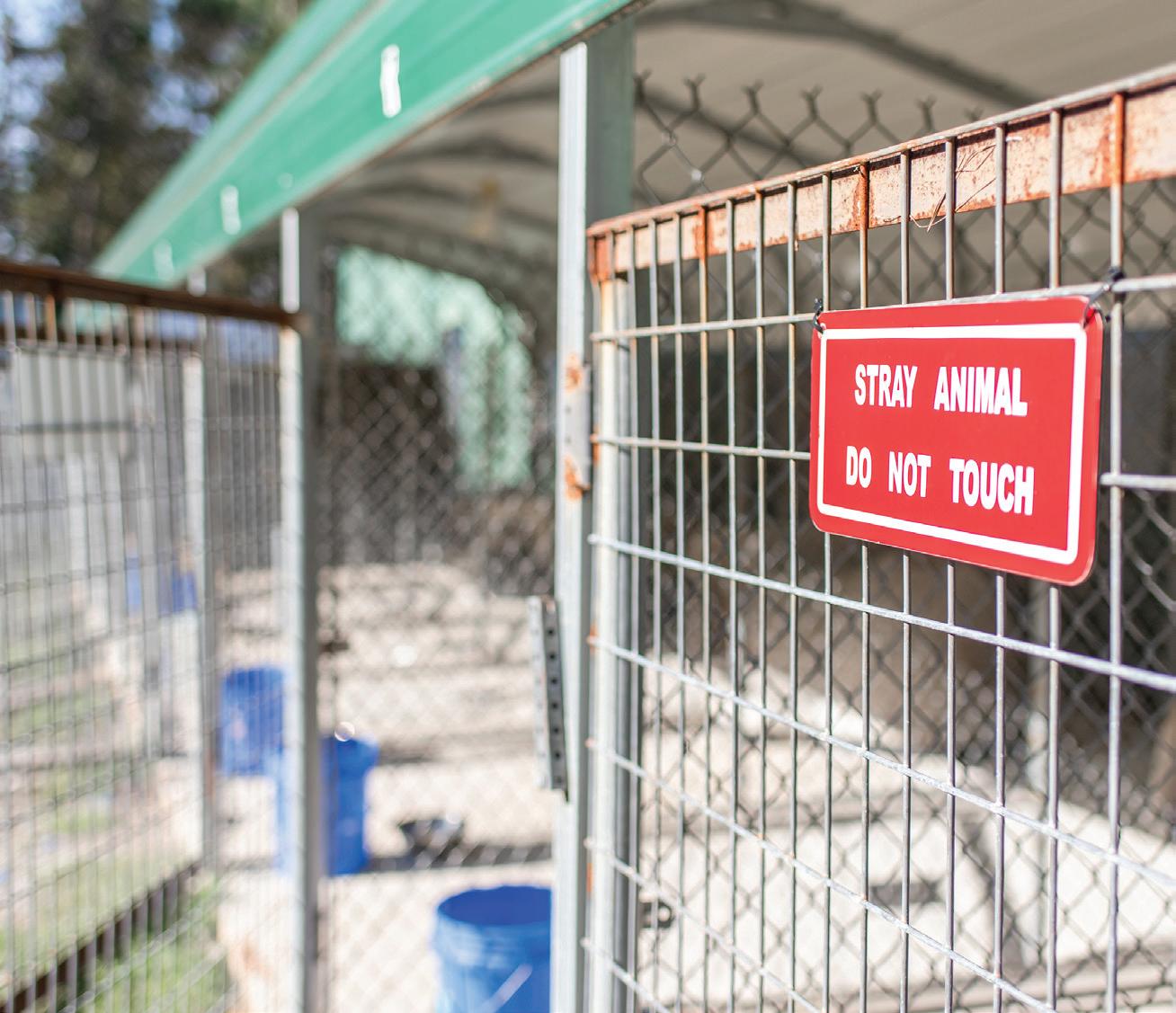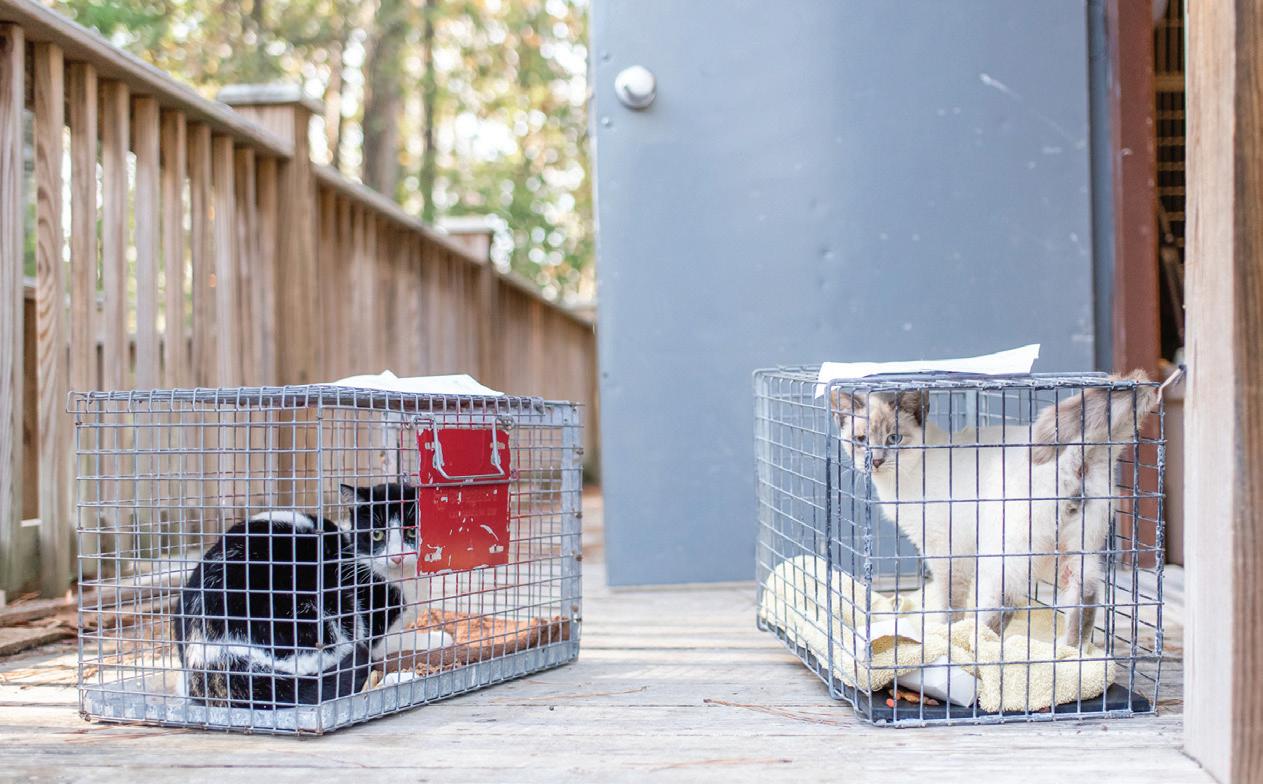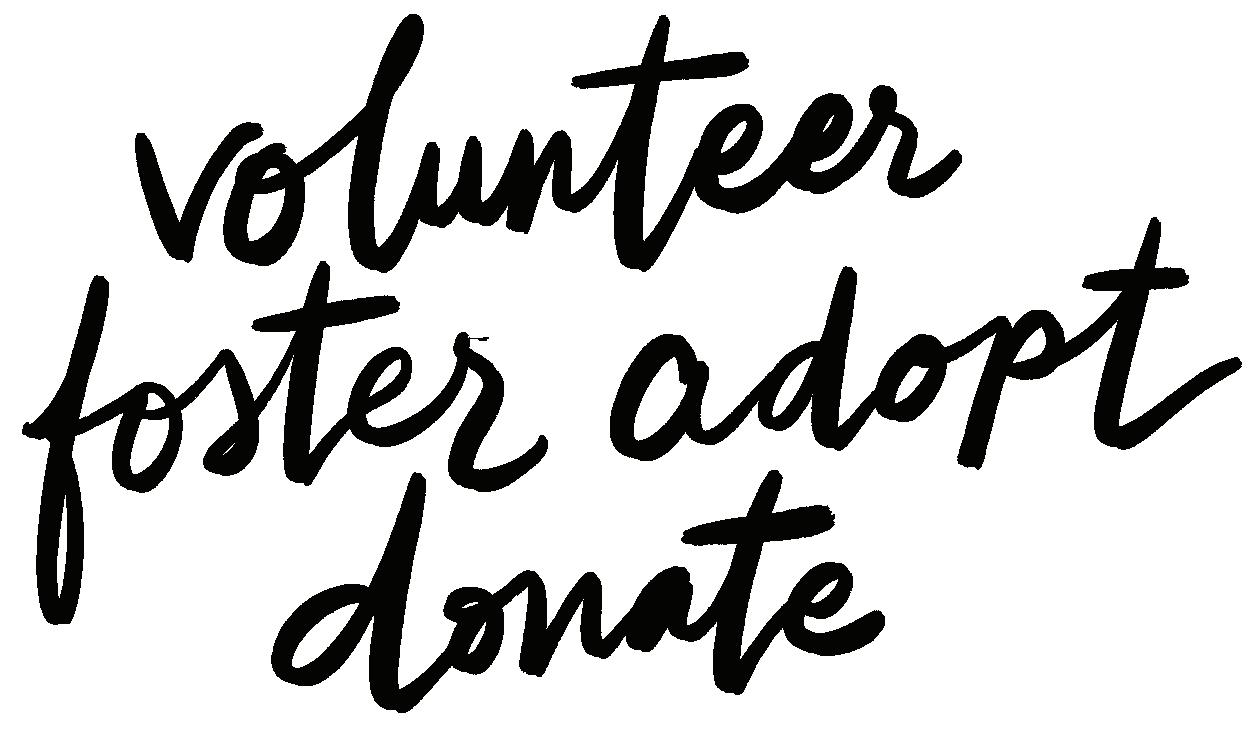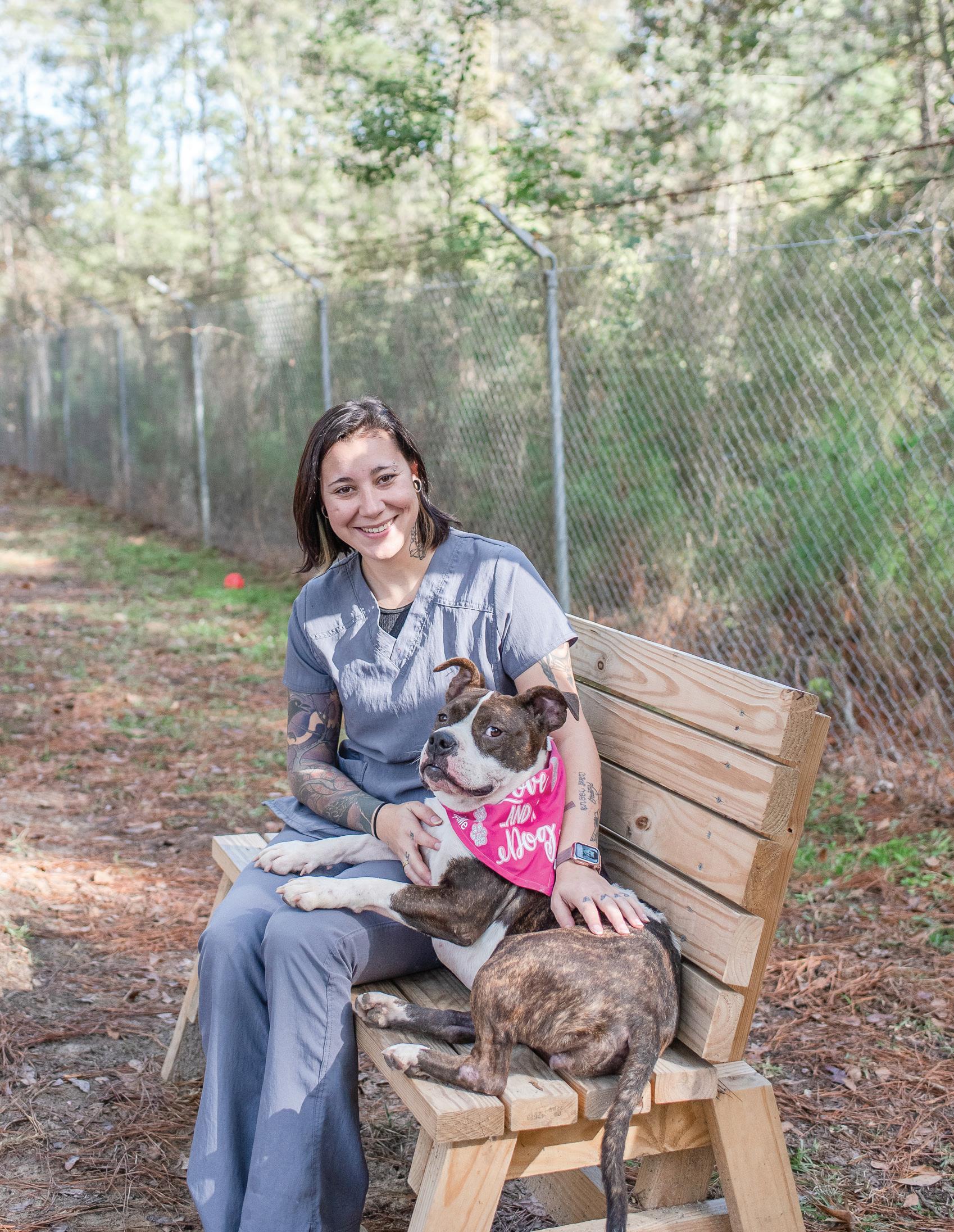
9 minute read
A Day in a Life of a Shelter Worker
The first thing you notice when you walk into the Berkeley County Animal Center is the smell. It doesn’t smell dirty, but it has that typical animal shelter smell of bleach mixed with urine and dog funk. The next thing you notice under the bright fluorescent lights is a cage with four adorable kittens to the right and a bulletin board full of missing cat posters to the left. An animal control officer walks in to inform the staff that she has three more stray cats, bringing the total number brought in today to fifteen. It is not even noon yet. Dianne Shelley shakes her head and prepares to intake three more cats with no real place to put them.
It’s clear within a few minutes of meeting Dianne that she has a real passion for animal rescue. Working at a shelter like Berkeley isn’t easy; it’s the third biggest county in the state. It has one tiny animal shelter. That means every single stray or unwanted animal in the 1,228 square miles of Berkeley County is brought straight to Dianne and the crew at the BAC. When asked what got her into rescue, Dianne said it had always been integrated into her life. When she was a child, she dreamed of being a vet, and she was constantly surrounded by foster pets. She got a job working with animals out of high school and never looked back, aside from a short stint at Moe’s before returning to the animal welfare world where she belonged. Her past employment includes Dorchester Paws (formerly Francis R. Willis SPCA) and the Barker Lounge before finding her place at the BAC
Advertisement
in 2017. When asked what her favorite part about working in the rescue was, Dianne said she loves the feeling of making a difference and witnessing the growth as neglected and abused animals learn to be happy healthy pets. Plus, there is always some excitement buzzing around her, and there’s rarely a dull moment, something a lot of jobs don’t offer.

A typical day in the life of a shelter worker is long. Dianne gets to work between 7 and 8 am and doesn’t leave for around 12 hours. There’s a lot to be done before the shelter opens to the public at noon, and intakes start at 8 am. First up on the agenda is processing any strays brought in by animal control overnight. They have a key to the holding room where the animals can be safe until shelter workers arrive in the morning. Once that is complete, Dianne can begin the process of preparing everyone’s morning medication. Every animal has a unique case, so sometimes, this task can be pretty time-consuming. If they are understaffed that day, Dianne helps with cleaning out the kennels and day to day upkeep of the shelter. There’s a lot of work to be done as they have over 50 dogs and 100 cats. Aside from the adoptable cat rooms and dog rooms, there are several quarantine rooms for both dogs and cats. There is also an outdoor run that houses even more dogs. There is a row of kennels that

are explicitly reserved for dogs that have been brought in by animal control and are waiting on their owners to come to pick them up. Sometimes, this can take days and even weeks. There are animals everywhere.

After all the animals have received their morning care, it is time for Dianne and the
rest of the crew, to turn their attention to the animals that aren’t housed in their shelter. Fosters come in to receive updated vaccines, and people bring their pets in for the meet and greets with potential adopters. Strays are brought in almost hourly by animal control to be processed and vetted. Volunteers come in to walk the dogs and sometimes take them for fullday excursions or sleepovers, which lightens the load a little. Still, the number of strays can quickly get overwhelming.
Once the strays are processed and assessed, it’s time for Dianne to decide who needs to get fixed and who is ready to go to foster care. She also considers the possibility of them being picked up by another rescue to adopt out. After that, it’s time to start all over again with second walks, medications, and feeding time. Twelve hours after she arrives, it’s time to head home and get ready for another busy day of rescue work.

Like most careers, there are high and low aspects of rescue. It can be a thankless job, and the staff at BAC can feel the impact of that. Sometimes it can feel like they aren’t making a difference at all, like nothing matters. Feeling as though the number of strays coming in is

Don’t forget those four-legged family members! Reserve your session TODAY!
follow us
never-ending, and they will never be able to help them all. They can’t help them all, it just isn’t possible, but Dianne says the most rewarding part of the job is when they can help a dog or cat learn to be a pet and find their fur-ever home. Seeing a dog who once cowered and shook in the corner of their kennel learn to trust humans again is what makes the job worth all the tears and anger. Some days are better than others, and they can adopt 5-6 dogs out, and some days, none get to leave the shelter. The unpredictable nature of the job is what makes it different from your typical 9-5.



There is a dark side to working at a shelter like BAC, one that no one likes talking about. In a shelter like this one that is funded solely with taxpayers dollars and not private donations, there is little money to throw around. As a result, tough choices have to be made. Euthanasia is a part of every animal shelter, whether they claim to be “no-kill” or not. Some are “less-kill” than others, but you will be hard-pressed to find a shelter that doesn’t euthanize ever. Unfortunately, BAC has to euthanize more animals than a private or nonprofit run shelter. With no TNR (trap, neuter, release) program in place for stray or feral cats, over 60% of cats brought into the shelter have to be euthanized. This number is overwhelmingly high, especially when compared to a shelter that does have a TNR program. Shelters such as Charleston Animal Society only have to euthanize around 5% of the cats enter the building, because of the TNR program. Because of private rescues that pull dogs from BAC, the number of dogs euthanized at the shelter has improved to about 25% but that number is still high. Euthanasia is 100% the last resort but it has to be done if an animal is a danger to the public, itself or other animals or if the animal is too sick or hurt to live a healthy, happy life. No one wants to euthanize, but sometimes it is the only option. Since animal control isn’t euthanasia certified, the decision falls to Dianne and the crew at the BAC.
What can be done to lower those numbers? For starters, a TNR program HAS to be implemented to start saving cats. Dianne and her co-workers are pushing for a spay and neuter clinic at the animal center, unfortunately, there is a lot of red tape to work through. Independently run rescues have been pulling dogs from the shelter for years. Thanks to rescues similar to Eunoia, Carolina Coonhound, Pet Helpers, Carolina Boxer Rescue, Lowcountry Lab, etc.., many dogs have been saved from euthanasia. BAC has limited kennels available, especially since some of them have to be left open for animal control. By leaving those kennels available, any dog can be transferred to another rescue going into doggie foster care if accessible. Purebred dogs are less challenging to move to breed-specific rescues, and most of the time, they barely see the inside of a kennel before being picked up by a relief organization. Because of rescues like these, the number of dog euthanasias is decreasing yearly. This alone, however, is not enough.
Because the BAC is a government entity, they are not allowed to accept private donations, so organizations like Friends of BAC step in to fundraise for them. Friends of BAC actually raised around $15,000 for a new surgery room! If you are unable to donate financially, donate your time. They always need volunteers to help clean the kennels and walk the dogs. You can even come to take a dog for the day or overnight just to get them out of the shelter and show them a little fun.
The cats need socializing too. There are so many of them, and the friendlier they are, the more likely they are to get adopted. Fostering is also a huge and vital way to help. The more kennels that are available, the more animals the shelter can save. Foster homes = empty kennels. You are under no obligation to adopt, but if you do decide, your foster would be the perfect fit for you, you are entitled to first “dibs.” Finally, we need to elect county officials that CARE! They are the ones who decide where our money goes, so electing people who want to spend money taking care of our animals.

www.lowcountrydog.com So what can we do to help? After all, it is our job as a community to help our animals. It isn’t fair to expect a shelter that is mainly left underfunded to be able to keep up with the number of animals coming in every day. We have to do something. Of course, the easiest way to help is to donate.


Animal rescue is no joke. Between the long hours, a thankless community, and tough life or death decisions, the job can be overwhelming and sometimes can feel like nothing makes a difference anyway. Thankfully for the city of Berkeley County, there are people like Dianne Shelley, who have dedicated their time and life to fixing our problem. The lack of space and funding isn’t the shelter’s problem, it is the community’s. It is about time we step up and do our part to limit the number of strays and surrendered pets coming through the shelter. Fostering, donating, and electing people who care is just the beginning of what we need to do to save our animals, but it’s a start.
WRITTEN BY CHELSEA SALERNO
PHOTOGRAPHY BY SOUTHERN VINTAGE PHOTOGRAPHY







